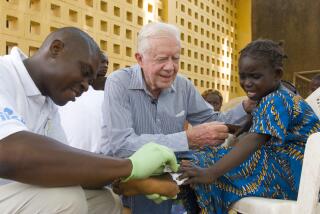India’s Vow to Eliminate Leprosy by Year 2000 Is Too Late for Millions of Sufferers
- Share via
NEW DELHI — The government has pledged to wipe out leprosy in this decade, but it is far too late for Laxman, a 70-year-old with no fingers or toes who begs outside a hospital.
Laxman contracted the disease 35 years ago in his remote home village in northern India, where he was a farm laborer. It began with white blotches on his hands and feet, which gradually became large wounds.
It was miles to the nearest hospital that supplied Dapsone, the only anti-leprosy drug then available.
“I was too poor to afford a pair of shoes,” Laxman said, “so I walked barefoot to the hospital.” He said that the rough roads grazed his ulcerated feet but that he felt no pain because the disease had deadened the nerves.
Doctors told Laxman that he would have to take Dapsone all his life to keep the disease at bay, but the hospital didn’t have a regular supply of the drug and “there were times when I was sick and couldn’t make it.”
Laxman is free of leprosy now but cannot work; for 20 years he has made his living as a beggar outside the hospital.
He is one of an estimated 4 million lepers in India, which has more than any other country--about one-third of the world’s cases.
Pursuing its pledge to eradicate the disease by the end of the century, the government began the annual anti-leprosy week in January by launching public-awareness programs and opening several new treatment centers.
India spends $17.8 million a year to combat leprosy, which cripples, disfigures and paralyzes but rarely kills, and can be cured if detected early.
It is caused by the Mycobacterium leprae bacillus, which first afflicts the skin and then invades the peripheral nerves, paralyzing muscles and tendons.
Doctors say that few victims know that leprosy is curable and that many lepers, fearing social ostracism, hide the early symptoms and avoid medication.
The government did not make concerted efforts to control the disease until 1982, when it provided multidrug therapy in two of the 200 districts where leprosy was endemic.
Only four more districts had been added by 1985, but the treatment reached 137 in 1990. The government hopes to have multi-drug therapy in all endemic districts by the end of this year, said B. N. Mittal, a Health Department official who coordinates federal anti-leprosy programs.
Mittal said that will leave 500,000 to 600,000 untreated lepers, about 15% of all cases. Theoretically, he said, they will not spread the infection, and it eventually will disappear unless there were new outbreaks.
Leprosy is believed to be communicable only through long and close contact, but poor, undernourished people can harbor and spread it for many years without visible signs. A complete cure requires multidrug treatment for at least two to three years.
Even after they are cured, lepers are shunned by society and denied jobs.
Many Indians believe that leprosy is a curse of the gods. Seven of the 25 states enforce a 1898 law that bars lepers from government jobs, public transport and inheriting property.
“Our weakest link is lack of rehabilitation,” Mittal said of the lepers. “It’s unfortunate that we can kill the bacilli, but can’t restore their dignity.”
Nearly all the government’s anti-leprosy budget goes for treatment, and little provision is made for rehabilitation, he said.
Charities and Christian missions have opened leper homes, but there is little help in remote and underdeveloped regions.
Many cured lepers such as Laxman work as beggars, living in shanties or overcrowded leper colonies.
Dr. Stephen Atwood, an American who has coordinated several health projects in India, said: “We’re looking at whole people here, not just diseases. I don’t think you can handle medical care without social rehabilitation.”
More to Read
Sign up for Essential California
The most important California stories and recommendations in your inbox every morning.
You may occasionally receive promotional content from the Los Angeles Times.












